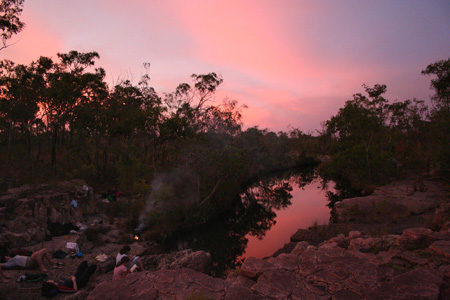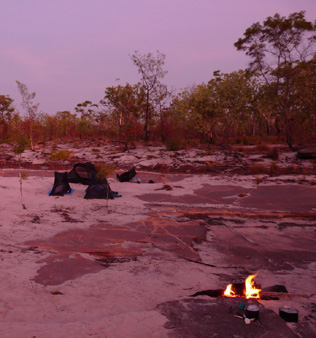Gunumeleng — The Build Up — The Most Dramatic season of All
This page is out of date. It is still here because this site contains a variety of general information like our newsletters and our Covid Blog page which has not yet been uploaded to our new website.
For up to date information about specific trips, see our new mobile-friendly website.

Gunumeleng is the word the Aboriginal people from northern Kakadu use to describe the pre-monsoon period. Further south, the climate is different enough so that the Jawoyn people split this season into two — Julgalk is the early part and Guran the final period before the monsoon begins in earnest. But, whatever you call it, this is the most dramatic season of all.

Picture the scene. The hot, dry weather of September turns into the hotter, more humid weather of October and November. All but a few creeks have completely disappeared. Major rivers are reduced to a series of isolated waterholes. The land lies brown and parched, waiting, still, silent and sweltering.
Suddenly, a wind springs up. In a matter of minutes, the temperature drops five or even ten degrees. The first few drops of rain turn into a torrent as lightning flashes and thunder roars. Then it is over and still once more. Then the frogs began to call and the birds begin to sing. The land turns green again, almost as you watch. All nature rejoices in the change. This is when the Leichhardt grasshopper makes its annual appearance and some of the wildflowers put on their best displays. The Aboriginal traditional owners from this region call the grasshopper Al-yurr, meaning children of the lightning man, Namarrgon, a powerful ancestral being. The country around Darwin and across to Arnhem Land has one of the highest incidences of lightning in the world. Namarrgon is commonly depicted in the regions rock art with axes hanging from his body, which he uses to strike the clouds. Around Kakadu the axes on his head represent grasshopper's antennae.


Even in this, the hottest time of year, there are a few beautiful, cool, shady creeks and gorges where the bushwalker can relax and watch the birds as they come in for a drink or listen to the cicada chorus which announces the coming change. Knowledgeable locals head bush at every opportunity, leaving the ignorant to swelter in the city. Our routes have been chosen with relaxation, swimming and shade in mind. Walking will generally be restricted to early in the morning and late in the afternoon. The hot middle part of the day will devoted to taking it easy and soaking up the sights and sounds of the environment around us. Wherever possible, we will start walking early in the morning and have long lunch breaks where you can read, relax, swim and enjoy the bush around you.
Look at the pictures below. Every one of these pictures was taken in the Build Up between between the last week in September and end of November. Do these look like places you might enjoy?
Leave your pointer on the photo and you'll see a caption. Click the photo for an enlarged view. Click the back button to return to this screen.
 Our Gunumeleng (Build Up) trips are the most laid back and relaxed that we offer — early starts, early finishes and long lunch breaks sitting by tranquil pools. If you want to cover the maximum distance in the minimum time, this is not the time to visit. However, if you would like to enjoy a more leisurely trip, relaxing and soaking up the sights, scents and sounds of the natural world around you, one of our Build Up trips could be exactly what you are looking for.
Our Gunumeleng (Build Up) trips are the most laid back and relaxed that we offer — early starts, early finishes and long lunch breaks sitting by tranquil pools. If you want to cover the maximum distance in the minimum time, this is not the time to visit. However, if you would like to enjoy a more leisurely trip, relaxing and soaking up the sights, scents and sounds of the natural world around you, one of our Build Up trips could be exactly what you are looking for.
There's more, much more. Have a look at our Build Up Season — What to Expect page and see for yourself. There are lots of photos so the page might take a while to load.
Willis's Walkabouts, 12 Carrington Street, Millner NT 0810, Australia walkabout@bushwalkingholidays.com.au
Last Modified Tuesday, 11-Aug-2020 22:27:07 EDT | Valid XHTML1.0



 share
share